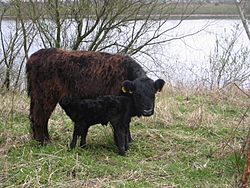Galloway cattle facts for kids

Galloway cow with calf
|
|
| Country of origin | Scotland |
|---|---|
| Use | Beef |
| Traits | |
| Weight |
|
| Coat | Black, some countries recognise red. Dun |
| Horn status | Polled |
|
|
The Galloway is a very old type of beef cattle. It is named after the Galloway area in Scotland, where it first appeared in the 1600s.
Today, you can find Galloway cattle in many parts of the world. They were first sent to Canada in 1853, the United States in 1882, and Australia in 1951. These cattle were very popular in the 1950s. Their numbers went down during a cattle disease scare, but now they are becoming popular again because of the demand for their meat. Galloways are known for their thick coats, which help them live in cold places like Scotland.
Contents
What's in a Name?
The name "Galloway" comes from an old region in southwest Scotland. The word itself comes from "Gallovid" or "Gallgáedil," which were old names for people from that area.
History of the Galloway Breed
Galloway cattle came from the native cows of southwest Scotland. They were fully developed as a breed in the 1600s. At first, these cattle came in many different colors and patterns. The first official book for Galloway cattle only listed black cows. But some Galloways were born red because of a hidden gene. Later, "dun" (a brownish-gray color) Galloways were also allowed in the official book. So, even though most Galloways are black, you can also find red and dun ones. The Galloway Cattle Society was started in 1877 to keep track of the breed.
Galloway cattle arrived in Canada in 1853. The first official records for them in the United States began in 1882. By 1911, over 35,000 Galloways were recorded in the American Galloway Herd Book. The British Galloway Society was formed in 1908. They first did not accept dun-colored Galloways, but this rule was later changed. In 1951, Galloway cattle were brought to Australia.
In the 1950s, Galloway cattle were very successful. This was because people wanted cows that did not need a lot of food but still produced high-quality meat. However, in 1990, a cattle disease scare caused a ban on exporting these cows. Even though no Galloway cattle were found to have the disease, people became worried about cattle in general. This caused the number of Galloway cattle to drop.
In recent years, there has been a demand for larger, leaner cattle. This led to some changes in how Galloways were bred, like using artificial insemination. Today, the original traits of the Galloway breed are popular again. This is because people want good quality meat that can be produced without too much cost.
Characteristics of Galloway Cattle
A typical Galloway cow weighs between 1,000 and 1,500 pounds. A bull usually weighs between 1,700 and 2,300 pounds. A healthy Galloway calf weighs about 75 pounds when it is born.
Galloways have a special thick coat with two layers. It is wavy or curly. This thick coat keeps them very warm, so they don't need a lot of body fat. This means there is less waste when they are used for meat. Their thick coat sheds (falls out) during the summer or in warmer places. Even though they are mostly raised for meat, some Galloway herds in Cumberland were once milked to make cheese!
Galloway cattle are naturally hornless, meaning they don't grow horns. Instead, they have a bony bump on top of their head called a "poll." Their shaggy coat has a soft, woolly undercoat for warmth and stiffer outer hairs that help water run off. This makes them very good at living in tough, cold climates.
Population Size
It is believed that there are fewer than 10,000 Galloway cattle around the world. Most of them live in Northern Europe, especially Scotland. In the United States, the breed is considered "rare." The Livestock Conservancy lists them as a breed to "watch" to help protect their numbers.
Societies
See also
 In Spanish: Galloway cattle para niños
In Spanish: Galloway cattle para niños

